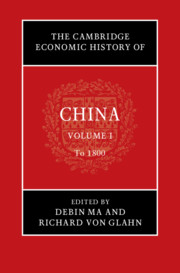
-
Select format
-
- Publisher:
- Cambridge University Press
- Publication date:
- February 2022
- February 2022
- ISBN:
- 9781108587334
- 9781108425575
- Dimensions:
- (228 x 152 mm)
- Weight & Pages:
- 1.32kg, 732 Pages
- Dimensions:
- Weight & Pages:
- Subjects:
- East Asian History, Area Studies, Asian Studies, History, Economic History
- Collection:
- Cambridge Histories - Asian History
You may already have access via personal or institutional login- Subjects:
- East Asian History, Area Studies, Asian Studies, History, Economic History
- Collection:
- Cambridge Histories - Asian History
Book description
China's rise as the world's second-largest economy surely is the most dramatic development in the global economy since the year 2000. But China's prominence in the global economy is hardly new. Since 500 BCE, a dynamic market economy and the establishment of an enduring imperial state fostered precocious economic growth. Yet Chinese society and government featured distinctive institutions that generated unique patterns of economic development. The six chapters of Part I of this volume trace the forms of livelihood, organization of production and exchange, the role of the state in economic development, the evolution of market institutions, and the emergence of trans-Eurasian trade from antiquity to 1000 CE. Part II, in twelve thematic chapters, spans the late imperial period from 1000 to 1800 and surveys diverse fields of economic history, including environment, demography, rural and urban development, factor markets, law, money, finance, philosophy, political economy, foreign trade, human capital, and living standards.
Reviews
‘I enjoyed reading the first volume of The Cambridge Economic History of China and highly recommend it to others who want to go a bit beyond short surveys on this area without getting too tangled in the weeds. While not intending to be ‘revisionist’ per se, it is sure to challenge some preconceived beliefs about the world’s largest nation - and its dynamic, vibrant, and rich history.’
Jamin Andreas Hübner Source: EH.net (Economic History Association)
Contents
Metrics
Altmetric attention score
Full text views
Full text views help Loading metrics...
Loading metrics...
* Views captured on Cambridge Core between #date#. This data will be updated every 24 hours.
Usage data cannot currently be displayed.
Accessibility standard: Unknown
Why this information is here
This section outlines the accessibility features of this content - including support for screen readers, full keyboard navigation and high-contrast display options. This may not be relevant for you.
Accessibility Information
Accessibility compliance for the PDF of this book is currently unknown and may be updated in the future.


